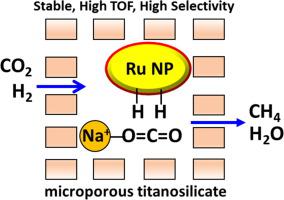Journal of Catalysis ( IF 6.5 ) Pub Date : 2022-06-21 , DOI: 10.1016/j.jcat.2022.06.011 Won Kyung Moon , Zhen Hao Lee , Min Hwangbo , Son Docao , Min Gyu Kim , Kyung Byung Yoon

|
Catalytic thermal hydrogenation of CO2 to CH4 with renewably produced H2 is one of the routes to reduce the CO2 concentration in the atmosphere. In this respect, various catalysts have been developed. Among them, 5% Ru-loaded Al2O3 [Ru(5%)-Al2O3] has shown the highest performance, at 300 °C, in terms of the intrinsic reaction rate and the turnover frequency (TOF), which were 38 mmolCH4 g−1h−1 and 1188 h−1, respectively. The CH4 selectivity of the catalyst was 95%. Despite of the above and other achievements, the developments of the catalysts that exhibit higher performances should be continued. This work now reports that 1% Ru-loaded ETS-10 [Ru(1%)-ETS-10] and 1% Ru-loaded TiO2 [Ru(1%)-TiO2] give the intrinsic reaction rates of 329 and 266 mmolCH4 g−1h−1, TOFs of 3321 and 2684 h−1 with the CH4 selectivities of 85.8 and 97.9%, respectively. In particular, Ru(1%)-ETS-10 is superior to Ru(1%)-TiO2 in terms of the stability (stable for more than 130 h). The analyses of the above three catalysts suggested the guidelines to prepare high performance catalysts, which are the support should be microporous materials and should possess the capability to introduce metal ions into the support by cation exchange so that they can be activated to metal nanoparticles by reduction, the support should be able to stabilize the metal nanoparticles, the active metal catalysts should be 2–5 nm sized three-dimensional (3D) Rux nanoparticles, the loading level of Rux nanoparticles should be 1%, the support should have the affinity to capture CO2 so that the catalyst can have the dual functionality of CO2 capture and CO2 reduction, the Rux nanoparticles should be highly basic, and the prepared Rux nanoparticles should not be poisoned by CO.
中文翻译:

用氢气制备 CO2 甲烷化的活性、选择性和稳定的负载型金属催化剂指南
用可再生产生的H 2将CO 2催化热加氢为CH 4是降低大气中CO 2浓度的途径之一。在这方面,已经开发了各种催化剂。其中,负载 5% Ru 的 Al 2 O 3 [Ru(5%)-Al 2 O 3 ] 在 300 °C 的本征反应速率和转换频率 (TOF) 方面表现出最高的性能,分别为 38 mmol CH4 g -1 h -1和 1188 h -1。CH 4催化剂的选择性为95%。尽管取得了上述和其他成就,但应继续开发表现出更高性能的催化剂。这项工作现在报道了 1% Ru 负载 ETS-10 [Ru(1%)-ETS-10] 和 1% Ru 负载 TiO 2 [Ru(1%)-TiO 2 ] 给出了 329 和266 mmol CH4 g -1 h -1,3321 和2684 h -1的TOF ,CH 4选择性分别为85.8 和97.9%。特别是Ru(1%)-ETS-10优于Ru(1%)-TiO 2在稳定性方面(稳定超过 130 小时)。对上述三种催化剂的分析提出了制备高性能催化剂的指导方针,即载体应为微孔材料,并具有通过阳离子交换将金属离子引入载体的能力,使其能够通过还原活化为金属纳米颗粒。 , 载体应该能够稳定金属纳米粒子, 活性金属催化剂应该是 2-5 nm 尺寸的三维 (3D) Ru x纳米粒子, Ru x纳米粒子的负载水平应该是 1%, 载体应该有捕获CO 2的亲和力使催化剂具有CO 2捕获和CO 2的双重功能还原时,Ru x纳米粒子应具有高碱性,制备的 Ru x纳米粒子不应被 CO 毒化。











































 京公网安备 11010802027423号
京公网安备 11010802027423号